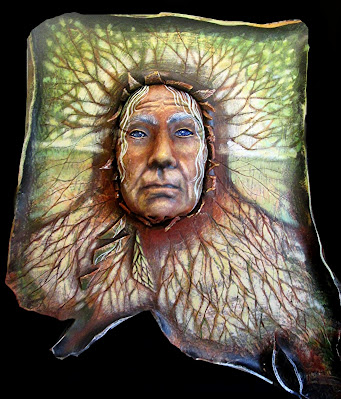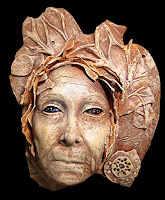Asherah was one of the three great goddesses of the Canaanite pantheon. In Canaanite religion her primary role was that of mother goddess. In mythological texts from the Late Bronze Age (c. 1550–1200 b.c.e.) city-state of Ugarit, she is called “the creatress of the gods”; her consort at Ugarit, the god El, is called “creator.” El is also referred to as father and patriarch at Ugarit, as Asherah, likewise, is called mother. Their children form the pantheon of the gods, who are said to number seventy; a Hittite myth similarly mentions the seventy-seven and eighty-eight children of Asherah. On occasion in Ugaritic myth, Asherah performs the maternal role of wet nurse. Ugaritic and other Canaanite materials further associate Asherah with lions (indicating power), serpents (representing immortality or healing), and sacred trees (signifying fertility). Thus Asherah’s children at Ugarit can be called her “pride of lions”; the goddess is called “lady of the serpent” in second-millennium b.c.e. inscriptions from the Sinai; the late-thirteenth-century b.c.e. Lachish ewer dedicated to Asherah is decorated with images of sacred trees.
The Canaanite association of Asherah with sacred trees is also found in Israelite tradition. For example, one of the Canaanite epithets of Asherah, elat, “goddess,” is etymologically identical to the Hebrew word for the terebinth tree (ela). Another word for “terebinth” (alla) and two words for “oak” (elon and allon) are also closely related. Gen 2:4b–3:24 may further suggest the association of Asherah with sacred trees, since the way that Eve, “the mother of all living” (3:20), is described in the Eden story mimics in certain respects the role of the Canaanite mother goddess Asherah. If a correspondence holds, then the trees of life and of knowledge in the Eden narrative may also reflect Asherah imagery.
Most significant, though, in demonstrating Israel’s association of Asherah with sacred trees are biblical materials that describe the asherah (singular) or asherim (plural), the cult object(s) that are associated with the goddess Asherah more than thirty times in the Hebrew Bible. These cult objects are generally described as being in the shape of a pole or stylized tree. Like a pole or tree, they can be said to be planted, stood up, or erected. Conversely, when destroyed, these cult symbols can be described as being cut down, hewn down, or uprooted; they can also be said to be burned, overturned, or broken. Both the Greek and Latin translations of the Bible, moreover, render the words asherah and asherim as “grove” or “wood.”
According to the biblical record, these sacred poles or stylized trees associated with Asherah were erected by the Israelites throughout most of their history, especially during the premonarchic (tribal) period (Judg 6:25–26, 28, 30)) and during the period of the divided monarchy, both in the northern kingdom of Israel (1Kgs 14:15; 16:33; 2 Kgs 13:6; 17:10, 16; 23:15; and parallel references in 2 Chronicles) and in Judah, in the south (1 Kgs 14:23, 15:13; 2 Kgs 18:4; 21:3, 7; 23:6, 14; and parallel references in 2 Chronicles). These sacred poles were situated in various locations. In Judges 6, a sacred pole of Asherah is said to have stood beside the altar of the Canaanite storm god, Baal. The Bible also connects sacred poles with the “high places” (open-air cult sites?) and frequently mentions that they stood “on every high hill and under every green tree” (1 Kgs 14:23; 2 Kgs 17:10; 18:4; 21:3; 23:13–14; 2 Chr 14:3; 17:6; 31:1; 33:3, 19; 34:3; Jer 17:2). Both of these phrases are stereotypically used by the biblical writers to describe sites of idolatrous worship, implying, as does Judges 6, that the worship of Asherah was an apostate behavior in Israel and improper for followers of YHWH.
Yet despite these and other references associating Asherah with apostasy and despite the fact that the Israelites are explicitly forbidden to erect one of Asherah’s sacred poles beside an altar of YHWH, there are multiple indications in biblical tradition that many in ancient Israel did regard Asherah’s icon as an appropriate sacred symbol within the religion of YHWH. For example, one of Asherah’s sacred poles stood in the northern kingdom's capital city of Samaria. The sacred pole of Samaria, moreover, which was erected during the reign of King Ahab (reigned 873–852 b.c.e.) was allowed to remain standing by the reformer King Jehu in later days even though he was at pains to remove all non-Yahwistic imagery from the land otherwise.
Archaeological discoveries from the late 1970s and early 1980s have further indicated that, at least in the opinion of some ancient Israelites, YHWH and Asherah were appropriately worshipped as a pair. From the site of Kuntillet ‘Ajrud, in the eastern Sinai, come three ninth- or eighth-century b.c.e. inscriptions that mention YHWH and “his Asherah” (meaning YHWH’s companion [consort?], the goddess Asherah) or “his asherah” (meaning YHWH’s sacred pole that represents the goddess Asherah and that sits in his temple or beside his altar). An eighth-century b.c.e. inscription from Khirbet el-Qom, about twenty-five miles southwest of Jerusalem, contains similar language in 1 Kgs 15:13 and 2 Kgs 18:4, 21:7, and 23:6 (with parallels in 2 Chronicles) indicate that at least during certain points in the ninth, eighth, and seventh centuries b.c.e., Asherah’s sacred pole was perceived as an appropriate icon to erect in Jerusalem, even in YHWH’s temple.
Whether women, more generally, were more likely to be devotees of Asherah’s cult is unknown. There is some biblical evidence that does see women as particularly attracted to goddess cults (for example, women’s role in the cult of the queen of heaven, according to Jer 7:18 and 44:17–19, 25), and the various female figurines found in domestic contexts at multiple Israelite sites might also suggest this, assuming, as many scholars do, that women played an especially important role in family-centered religious activities. Nevertheless, the presence of Asherah’s cult in the Jerusalem temple and in the cult city of Bethel indicates that worship of the goddess was also appealing to men, given that it was an all-male clergy that officiated at these (and at every) Israelite religious site.
The presence of Asherah’s cult in Israel also raises questions about the nature of the monotheistic confession that is often assumed to be a core principle in Israelite faith. Generally speaking, biblical scholars assume that full-blown, radical, or philosophical monotheism came to Israel fairly late in its history, during the time of the exile in the sixth century b.c.e. Prior to this, we have abundant evidence that other gods and goddesses were worshipped in Israel in addition to (or sometimes instead of) YHWH. Yet even in these earlier materials, we sometimes see evidence of a phenomenon that comes to dominate in the exilic period: the impulse to assimilate the attributes of the many gods and goddesses of older polytheistic systems to the one god, YHWH. Language that speaks of God as mother, for example (as in Deut 32:18; Num 11:12–13; Isa 45:9–10, 49:15; 66:13), probably represents the assimilation of Asherah’s maternal characteristics to YHWH.




















